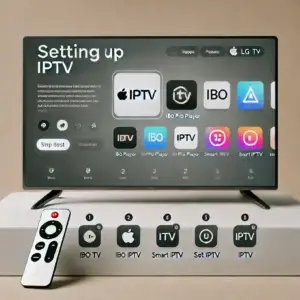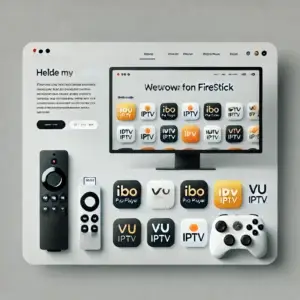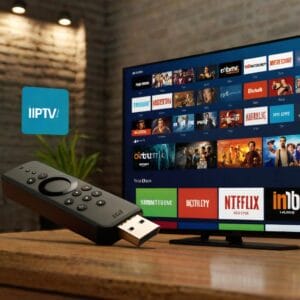Introduction to IPTV
Internet Protocol Television (IPTV) represents a revolutionary shift in how we consume television content. Unlike traditional cable and satellite TV, which rely on broadcast signals and cables, IPTV delivers television content using Internet Protocol (IP) networks. This means that TV content, including live broadcasts and on-demand shows, is streamed over the internet, much like how websites and other online content are accessed.
The mechanism behind IPTV is both straightforward and efficient. When a user selects a channel or a program, a request is sent through their internet connection to the IPTV server. The server processes this request and sends the requested content back to the user in real-time. This process allows for more flexibility and control over what and when you watch, as the content is delivered directly to your device without the need for traditional broadcasting infrastructure.
One of the primary reasons IPTV has rapidly gained popularity is the wealth of benefits it offers over conventional TV services. IPTV provides consumers with access to on-demand content, including movies, TV series, and other programs that can be watched at their convenience. This eradicates the need to adhere to a fixed broadcast schedule, making entertainment more flexible and personalized.
Moreover, IPTV often boasts superior streaming quality. With the right subscription, high-definition (HD) and even 4K content can be streamed seamlessly, provided the internet connection is strong and stable. This is a significant advantage over cable and satellite services, which can be limited by signal quality and bandwidth restrictions.
Cost-effectiveness is another critical benefit of IPTV. Traditional cable and satellite TV subscriptions can be expensive, often bundled with channels and services that subscribers may not use. IPTV, on the other hand, typically offers more affordable and flexible subscription models, allowing users to pay for only what they want to watch. For those who are budget-conscious or seeking to optimize their entertainment expenditure, IPTV solutions like those provided at https://gofiretv.com offer a compelling alternative.
Internet Connection Requirements
A stable and high-speed internet connection is crucial for an optimal IPTV experience. Unlike traditional cable services, IPTV relies heavily on your internet bandwidth to stream content seamlessly. For standard definition (SD) streaming, a minimum internet speed of 3 Mbps is generally recommended. However, for high definition (HD) streaming, speeds of at least 7 Mbps are advisable to avoid buffering and maintain picture quality. For ultra-high-definition or 4K content, the requirements are significantly higher, necessitating speeds of 25 Mbps or more to ensure smooth playback.
A reliable Internet Service Provider (ISP) is pivotal in achieving these speeds consistently. Choosing an ISP that has a good reputation for uninterrupted service and minimal downtime can make a significant difference in your viewing experience. It is also essential to consider the potential impact of network congestion, which can occur during peak usage times and degrade streaming quality. Ensuring that your ISP can handle high traffic without significant slowdowns is crucial.
Another critical aspect to consider is whether your ISP enforces data caps. Data caps restrict the amount of data you can consume within a billing cycle, which can be problematic for heavy IPTV users. Exceeding your data limit can result in additional charges or throttled speeds, which can severely impact your streaming experience. Therefore, opting for a plan without data caps or with a higher data limit is advisable for uninterrupted viewing.
In summary, a stable and high-speed internet connection is indispensable for IPTV services. Recommended speeds vary depending on the resolution of the content—3 Mbps for SD, 7 Mbps for HD, and 25 Mbps for 4K. Choosing a reliable ISP and understanding the impact of network congestion and data caps can ensure your IPTV experience remains seamless and enjoyable.
IPTV Set-Top Boxes
An IPTV set-top box is a crucial component of an IPTV (Internet Protocol Television) setup. It serves as an intermediary device, converting streaming signals received over the internet into a format that can be viewed on a television. This small yet powerful device makes it possible to enjoy a wide array of televised content without the need for traditional broadcasting methods.
Several popular set-top box options are available on the market, each bringing its unique set of features and benefits. Known for their reliability and user-friendly interface, MAG boxes are a predominant choice among IPTV enthusiasts. Models such as the MAG322 and MAG425A offer robust performance, with support for high-definition and 4K streaming, respectively. Additionally, these boxes are known for their straightforward installation and compatibility with various IPTV service providers.
Android TV boxes are another widely utilized option, revered for their versatility. With these devices, users gain access not only to IPTV services but also to a broad spectrum of apps available on the Google Play Store. Popular models like the NVIDIA Shield TV and Mi Box S are equipped with powerful processors and ample storage, ensuring smooth streaming experiences. The Android operating system also allows for easy customization and integration with other smart home devices, enhancing overall functionality.
Amazon Fire TV devices, such as the Fire TV Stick and Fire TV Cube, offer yet another appealing choice for IPTV setups. These devices are particularly noted for their compact design and ease of use. With Alexa voice control integrated, users can navigate through content effortlessly. Additionally, Fire TV products support a vast library of apps and streaming channels, providing an all-encompassing entertainment solution. Their compatibility with https://gofiretv.com services ensures reliable and enjoyable viewing.
When selecting an IPTV set-top box, consider the specific needs and preferences, such as required features, compatibility with existing equipment, and ease of use. Evaluating these factors will aid in making an informed decision, thereby enhancing one’s IPTV experience.
Smart TVs with Built-in IPTV Support
Smart TVs equipped with built-in IPTV support present an efficient and streamlined solution for accessing and enjoying http://gofiretv.com and other IPTV services. These TVs eliminate the need for external devices such as set-top boxes, providing a cleaner and more integrated home entertainment setup. This capability allows users to directly connect to IPTV services by downloading the relevant apps from the TV’s app store effortlessly.
One of the core advantages of a Smart TV with built-in IPTV support is its simplicity. Users can enjoy a seamless experience without navigating through additional cables or peripherals. Popular brands such as Samsung, LG, Sony, and Vizio have embraced this feature in many of their models, making it easier for consumers to find a suitable option within their preferred brand. For instance, Samsung’s QLED series and LG’s OLED models are renowned for their exceptional display quality and integrated IPTV capabilities.
However, potential buyers should be aware of a few considerations. Firstly, not all Smart TVs support every IPTV service on the market. It’s essential to verify that the TV can run the necessary applications required by your chosen IPTV provider. Additionally, while built-in IPTV support offers a convenient solution, it may not match the flexibility provided by dedicated IPTV set-top boxes which often come with more extensive software options and customization features.
Another factor to consider is the performance of the TV’s chipset and memory. While modern Smart TVs are equipped to handle multiple functions simultaneously, some models may experience slowdowns when streaming high-definition content or running multiple apps concurrently. Hence, opting for a higher-end model with robust processing capabilities can mitigate these issues and ensure a smoother user experience.
In conclusion, Smart TVs with built-in IPTV support offer a user-friendly, efficient way to access IPTV services like http://gofiretv.com. By selecting a compatible, high-performance model from a reputable brand, users can enjoy a streamlined, high-quality viewing experience.
Apps and Software for IPTV
The landscape of IPTV applications is broad, catering to various devices such as smartphones, tablets, PCs, and smart TVs. Among the prominent apps, IPTV Smarters stands out due to its compatibility with a wide range of devices. Available on iOS, Android, Windows, and MacOS, IPTV Smarters offers a user-friendly interface that simplifies the user experience. The software supports multiple formats, EPG guides, and several player options, ensuring flexibility and ease of use.
Kodi, another popular choice, is an open-source media player that supports IPTV through its numerous add-ons. Available for download on devices such as Android, Windows, iOS, MacOS, and Linux, Kodi provides extensive customization options. Its interface is slightly more complex compared to IPTV Smarters, making it more suitable for users who enjoy a higher degree of control and personalization. Kodi is also known for its robust community support and a wide array of add-ons that expand its utility far beyond traditional IPTV viewing.
VLC Media Player, a household name in media playback, also doubles as an effective tool for IPTV. Compatible with almost all platforms—Windows, MacOS, Linux, iOS, and Android—VLC stands out due to its simplicity and reliability. Users appreciate its straightforward setup process and the absence of additional costs for high-quality streaming. To set up IPTV on VLC, users need only to load an M3U playlist, ensuring a hassle-free experience.
Aside from these top-tier applications, numerous other IPTV apps cater to niche needs and preferences. For example, GSE Smart IPTV is praised for its robust feature set and compatibility with a range of devices, supporting both live and non-live streams. Similarly, Perfect Player is favored on Android devices for its clean interface and advanced functionalities like OSD and EPG features.
In summary, the wide array of apps like IPTV Smarters, Kodi, and VLC Media Player illustrate the versatility and accessibility of IPTV for users with varying needs. Each application provides a unique blend of features, ensuring that every user can find software that best fits their device and viewing preferences.
Networking Hardware
Achieving a seamless IPTV experience often hinges on the quality and configuration of your networking hardware. Essential components such as routers, modems, and wireless extenders play pivotal roles in ensuring that your streaming is without interruptions.
The first crucial device in your setup is the modem, which serves as the gateway between your internet service provider and your home network. For optimal IPTV performance, it is recommended to use a modem that supports the latest standards, such as DOCSIS 3.1. This ensures higher bandwidth capabilities and minimizes latency, which is essential for smooth streaming.
The next vital piece of networking hardware is the router. The router disseminates the internet connection throughout your home, and for a reliable IPTV experience, a dual-band or tri-band router is advisable. These routers can manage multiple devices more efficiently, reducing network congestion. Look for routers that support Quality of Service (QoS) settings, which allow you to prioritize IPTV traffic over other activities, drastically reducing buffering and improving streaming quality.
Your modem and router alone may not suffice if your IPTV setup involves streaming in various rooms or areas far from the primary network source. In such cases, wireless extenders or mesh network systems can prove invaluable. Wireless extenders amplify the signal extending your network’s range, while mesh systems offer a more sophisticated approach by providing multiple nodes that create a unified network blanket across your entire home, ensuring consistent coverage.
When selecting networking hardware, consider the internet speed offered by your ISP and ensure that your devices can handle these speeds. Investing in networking hardware from reputable brands that offer regular firmware updates can also enhance security and performance.
In summary, choosing the right networking hardware is crucial for an optimal IPTV experience. Ensuring you have a high-quality modem, router, and appropriate coverage solutions will allow for smooth streaming, providing an enjoyable viewing experience without interruptions.
Subscription Services
When exploring IPTV subscription services, it’s crucial to understand the various options available in the market. IPTV (Internet Protocol Television) providers generally offer both free and paid subscription models, each catering to different viewer needs and preferences.
Free IPTV services are appealing due to their cost-free nature; however, they often come with limitations. These can include a restricted selection of channels, lower streaming quality, and frequent service interruptions. Free services might be suitable for casual viewing or for those testing the waters before committing to a paid plan.
On the other hand, paid IPTV services provide a more refined experience with comprehensive channel selection, higher streaming quality, and enhanced reliability. Leading providers like Netflix, Hulu, and Amazon Prime not only offer extensive libraries of on-demand content but also live TV options. Services such as Sling TV, YouTube TV, and AT&T TV provide packages with a mix of live channels, including sports, news, and entertainment, catering to various audience preferences.
Pricing is a significant factor in selecting an IPTV service. Paid subscriptions usually follow a monthly or annual billing cycle, with costs varying based on the breadth of content and additional features offered. Major providers sometimes offer trial periods or tiered pricing to accommodate different budgets, allowing consumers to choose plans that best meet their needs.
Reliability and customer support are crucial metrics in evaluating IPTV providers. Reputable companies invest in robust infrastructures to ensure consistent streaming services with minimal downtime. Many offer 24/7 customer support channels to promptly resolve any issues and ensure a seamless viewing experience.
Choosing a reliable and reputable IPTV service is paramount. Unsanctioned or low-quality providers increase the risk of frequent service disruptions and poor customer support, which can diminish the viewing experience. To avoid such pitfalls, consumers are advised to research thoroughly, read reviews, and select providers known for their reliable services and strong reputation within the IPTV community.
Additional Accessories
When maximizing your IPTV viewing experience, several additional accessories can significantly enhance usability, audio-visual quality, and overall convenience. One of the most fundamental accessories is a high-quality remote control. While most IPTV subscriptions come with a standard remote, investing in an advanced, programmable remote can streamline navigation, allowing you to control multiple devices seamlessly. These remotes often come with customizable buttons that can be programmed for specific functions, adding a layer of convenience to your viewing experience.
External storage devices are another valuable addition. Many IPTV services offer DVR capabilities, but the internal storage of set-top boxes can be limiting. By connecting an external hard drive or SSD, you can expand your storage capacity, enabling you to save more shows, movies, and other content. This is particularly useful for avid viewers who prefer to keep a large library of recorded media.
High-definition multimedia interface (HDMI) cables play a crucial role in delivering superior audio-visual quality. Upgrading to a premium HDMI cable ensures that you get the best possible resolution and sound from your IPTV service. These cables are designed to handle higher bandwidths, supporting features like 4K video resolution and high dynamic range (HDR), thus providing a truly immersive viewing experience.
Finally, soundbars can drastically improve the audio component of your IPTV setup. While modern televisions come with decent built-in speakers, they often lack depth and clarity. A soundbar can bring a theater-like audio experience to your living room, enhancing both dialogue clarity and overall sound richness. Many soundbars also come with subwoofers that handle low frequencies, offering a fuller sound spectrum.
These additional accessories not only elevate the overall quality of your IPTV experience but also offer practical solutions to common issues like storage limitations and mediocre audio-visual performance. Investing in these enhancements can transform your household into a sophisticated entertainment hub, ensuring that you make the most out of your IPTV Subscription from services like https://gofiretv.com.





